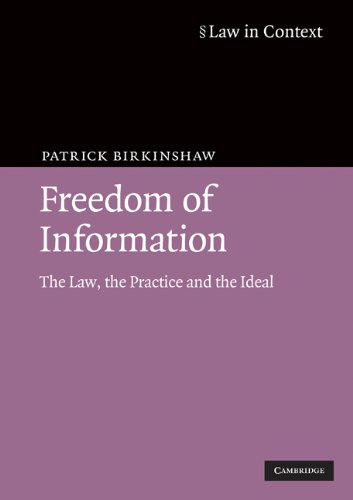

Most ebook files are in PDF format, so you can easily read them using various software such as Foxit Reader or directly on the Google Chrome browser.
Some ebook files are released by publishers in other formats such as .awz, .mobi, .epub, .fb2, etc. You may need to install specific software to read these formats on mobile/PC, such as Calibre.
Please read the tutorial at this link. https://ebooknice.com/page/post?id=faq
We offer FREE conversion to the popular formats you request; however, this may take some time. Therefore, right after payment, please email us, and we will try to provide the service as quickly as possible.
For some exceptional file formats or broken links (if any), please refrain from opening any disputes. Instead, email us first, and we will try to assist within a maximum of 6 hours.
EbookNice Team

Status:
Available0.0
0 reviews
ISBN 10: 052171608X
ISBN 13: 9780521716086
Author: Birkinshaw Patrick
Enacted in 2000 and in operation in the UK since 2005, the Freedom of Information (FOI) Act has revealed information which has generated calls for constitutional reform. A massive 'information jurisprudence' has developed through the decisions of the Information Commissioner, the Information Tribunal and the courts. Governments' responses to the war on terror have involved increased resort to claims of national security and accompanying secrecy, but these developments have to exist alongside demands for FOI and transparency. FOI has to balance access to and protection of personal information, and major amendments have been made to the Data Protection Act in order to balance the competing demands of transparency and privacy. This detailed discussion of FOI laws and personal data laws examines the historical development of secrecy, national security and government, and their modern context.
1 Persistent themes and novel problems
Computers and information
Reuse of public-sector information
The importance of information
Information and the state
Information and communication
Freedom of information, open government and transparency
Freedom of information – the good, the bad and the ugly
Information and institutional structure
2 Information and national security
Accountability and information
Some changes and questions
The security and intelligence services legislation and Regulation of Investigatory Powers Act (RIPA)
Interception of communications, surveillance and RIPA
Inquiries and national security
Reform – some food for thought?
The cost of freedom of information to national security
3 Government and information: a historical development
Crown, mace and information
Information and accountability – the struggle
Information and censorship
The executive and Parliament – the die is cast
Officials and secrecy in central government
Legal control of information
The Act of 1911
The Ponting trial
The Spycatcher litigation
The Shepherd Bill
The White Paper on reform
Public-interest disclosure
Prior publication
In Parliament
The Official Secrets Act 1989
Authorised disclosures
Security and intelligence information
Shayler’s trial
Defence
International relations and information received in confidence from states and international organis
Crime
Information relating to special investigation powers
Information entrusted in confidence to other states
Disclosure by recipients under s. 5
Safeguarding information
Miscellaneous
The OSA and privilege
The Attorney General
Public Interest Disclosure Act 1998 (PIDA)
4 The Freedom of Information Act 2000
The Act and its contents
Public authorities
Publication schemes
Public-interest disclosures, exemptions and the veto
Novel features
Open points
Denying the Commissioner the ultimate say
Responding to a request
Fees
The practicalities
Public records
The IT
reedom. of information
voices of freedom isbn
the freedom of information act
freedom of information summary
freedom of information act explained
what is a freedom of information act
Tags: Birkinshaw Patrick, Information, Law